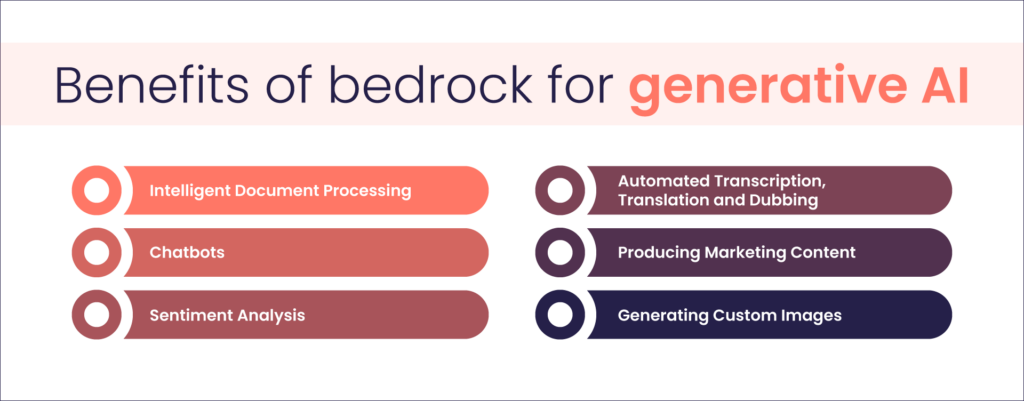Introduction
Amazon Bedrock is a platform for building and deploying generic AI models on a large scale. It provides tools for data preparation, model training, and deployment, as well as pre-trained models and scalable infrastructure. Bedrock enables enterprises to accelerate generic AI innovation across multiple domains and applications. Let’s dig deeper.
Understanding Generative AI
Generative AI involves training models to generate new data instances that are similar to the training data. These models learn the underlying patterns and structures of the data to produce realistic outputs. These are widely used in various domains, including image synthesis, text generation, music composition, and more.
Introduction to Amazon Bedrock
Amazon Bedrock is a platform for building and deploying generic AI models at scale. It offers a comprehensive set of tools and services to help streamline the complete generator AI model building process, from data preparation to model training and deployment.
Key Components of Amazon Bedrock
- Data Preparation Tools: AWS Bedrock provides data preparation and transformation tools to help train generative AI models. These tools help clean and normalize data, resulting in high-quality inputs for model training.
- Model Training Infrastructure: Amazon Bedrock provides a scalable platform for training generative AI models. Users can use Amazon Web Services (AWS) services such as Amazon SageMaker, which provide managed training settings that facilitate distributed training and automated model tuning.
- Pretrained Models and Algorithms: Bedrock contains a collection of pre-trained models and algorithms that users can use for a variety of generic AI projects. These pre-trained models serve as a starting point for bespoke model development, reducing development time.
- Model Evaluation and Monitoring: Bedrock provides tools for testing and monitoring generative AI models during training and deployment. Users can evaluate model performance, detect anomalies, and track model drift to ensure long-term accuracy and reliability.
- Deployment and Inference Services: Once learned, the generic AI model can be extended with Amazon Bedrock deployment and inference services. These services support real-time inference and batch processing, enabling customers to incorporate generative AI capabilities into their applications and workflows.

Workflow for developing generative AI models with Amazon Bedrock
Step 1: Data Collection and Preparation: Collect and preprocess training data to ensure it is clean, labeled, and indicative of the desired output. Use the data preparation capabilities of Amazon Bedrock to perform data enrichment, normalization, and other transformations as needed.
Step 2: Model Selection and Customization: Choose an appropriate pre-trained model or algorithm from the Bedrock library based on the generic AI challenge. Customize the model architecture and hyperparameters to optimize performance for the desired application.
Step 3: Model Training: Educate generic AI models with ready-made training data and model architecture. Use Amazon SageMaker or other Bedrock-provided training infrastructure to scale training and accelerate convergence on distributed compute resources.
Step 4: Model Evaluation and Validation: Assess the performance of trained models with validation data sets and metrics relevant to a generic AI task. Use Bedrock’s assessment tools to examine model output, identify flaws or biases, and ensure that the model meets quality criteria.
Step 5:Deployment and Integration: Deploy generative AI models developed through Bedrock’s deployment and inference services. Integrate models into production applications or workflows, enabling real-time or batch inference to generate new data instances as needed.
Step 6: Monitoring and Maintenance: Monitor the performance and behavior of deployed models over time using Bedrock’s monitoring tools to identify drift, anomalies, or performance degradation. Iterate on the model as needed, retraining or fine-tuning it to ensure peak performance.
Benefits of Using Amazon Bedrock for Generative AI
- Scalability: Bedrock uses AWS’s cloud architecture to provide scalable compute resources for training and deployment, allowing users to easily handle large-scale generative AI workloads.
- Efficiency: Bedrock accelerates the entire generative AI development lifecycle by providing pre-trained models, automated training pipelines, and managed deployment services, reducing go-to-market and development overhead.
- Efficiency: Bedrock Generative AI offers a diverse set of functions and use cases, allowing customers to select from a variety of pre-trained models, algorithms, and deployment options to meet their individual needs.
- Reliability: Bedrock, built on AWS’s flexible and reliable infrastructure, ensures high availability, security, and performance for generative AI models in production applications.
- Integration: Bedrock easily interacts with other AWS services and third-party tools, allowing users to add generative AI capabilities to their existing apps, workflows, and data pipelines.
Conclusion
Amazon Bedrock provides a comprehensive platform for designing and deploying generative AI models, allowing enterprises to leverage AI for creative tasks like image generation, text synthesis, and more. Bedrock streamlines the development process and accelerates innovation in generative AI across industries and applications by providing the tools, infrastructure, and pre-trained models.
If you want to know about AWS Bedrock pricing or AWS Bedrock tutorials, you can contact us directly.





No comment yet, add your voice below!